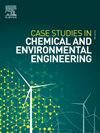了解稻虾联种紫糙米青芽过程中营养和抗氧化剂含量的变化
Q1 Environmental Science
Case Studies in Chemical and Environmental Engineering
Pub Date : 2025-09-26
DOI:10.1016/j.cscee.2025.101289
引用次数: 0
摘要
本研究考察了在越南湄公河三角洲稻虾养殖系统中生长的一种新的紫糙米品种的发芽条件对其营养和抗氧化特性的影响。采用响应面法优化温度(25-40°C)和时间(18-36 h),对关键生物活性成分γ-氨基丁酸(GABA)、游离氨基酸、总酚含量(TPC)和花青素进行增强。结果表明,萌发显著提高了GABA水平(最高0.015 mg/g)和游离氨基酸浓度(最高7.3 mg/g),这可能与酶激活和胁迫诱导机制有关。紫稻的主要抗氧化剂花青素含量显著下降,仅为原来的3%左右,这可能是浸泡和发芽过程中的热敏感性和氧化敏感性所致。记录的最大TPC为37.09°C,时间为22.25 h,虽然较原始值有所下降,但表明酶解结合的酚类物质补偿了部分降解。最佳发芽率为97.93%,花青素残留量适中(0.091 mg/g), GABA和氨基酸含量均有提高。研究结果强调了与发芽色素水稻相关的权衡,并提出了一种科学验证的方案,用于生产具有增强功能价值的发芽紫稻。本研究推进了从适合稻虾综合生态系统的当地品种中提取高价值、促进健康的稻米产品的创造。本文章由计算机程序翻译,如有差异,请以英文原文为准。
Understanding the change of nutritional and antioxidant content in purple brown rice grown in rice–shrimp farming systems during green germination process
This research examined the way germination conditions influence the nutritional and antioxidant profiles of a new purple brown rice variety grown in rice–shrimp farming systems in the Mekong Delta, Vietnam. Response surface methodology was employed to optimize temperature (25–40 °C) and time (18–36 h) for the enhancement of key bioactive components, including γ-aminobutyric acid (GABA), free amino acids, total phenolic content (TPC), and anthocyanins. The findings indicated that germination markedly enhanced GABA levels (up to 0.015 mg/g) and free amino acid concentrations (up to 7.3 mg/g), which can be ascribed to enzymatic activation and stress-induced mechanisms. Anthocyanins, the primary antioxidants in purple rice, significantly decreased, retaining approximately 3 % of their original concentration, likely due to thermal and oxidative sensitivity during soaking and sprouting. The maximum TPC recorded was 37.09 °C for 22.25 h, although it decreased from the original value, suggesting partial degradation compensated by the enzymatic release of bound phenolics. Optimal germination was achieved at 35.2 °C for approximately 26 h, as the optimal condition for achieving a high germination rate (97.93 %), moderate anthocyanin retention (0.091 mg/g), and increased levels of GABA and amino acids. The findings highlight the trade-offs associated with germinating pigmented rice and present a scientifically validated protocol for producing germinated purple rice with enhanced functional value. This study advances the creation of high-value, health-promoting rice products derived from local varieties suited to integrated rice–shrimp ecosystems.
求助全文
通过发布文献求助,成功后即可免费获取论文全文。
去求助
来源期刊

Case Studies in Chemical and Environmental Engineering
Engineering-Engineering (miscellaneous)
CiteScore
9.20
自引率
0.00%
发文量
103
审稿时长
40 days
 求助内容:
求助内容: 应助结果提醒方式:
应助结果提醒方式:


